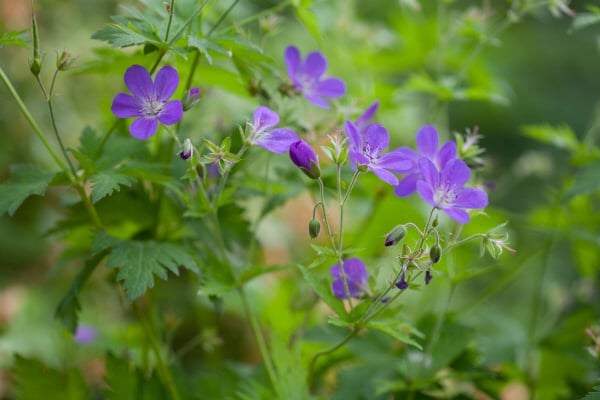Geranium sylvaticum
wood cranesbill
A medium-sized, deciduous perennial with divided and toothed leaves. Flowers are borne in May and June and are generally violet-blue with a white centre. It is a native of woodland and meadows
Size
Ultimate height
0.5–1 metresTime to ultimate height
2–5 yearsUltimate spread
0.1–0.5 metresGrowing conditions
Moisture
Moist but well–drained, Well–drainedpH
Acid, Alkaline, NeutralColour & scent
| Stem | Flower | Foliage | Fruit | |
| Spring | Blue White | Green | ||
|---|---|---|---|---|
| Summer | Blue White | Green | ||
| Autumn | Green | |||
| Winter |
Position
- Full sun
- Partial shade
Aspect
South–facing or North–facing or West–facing or East–facing
Exposure
Exposed or Sheltered Hardiness
H7Botanical details
- Family
- Geraniaceae
- Native to GB / Ireland
- Yes
- Foliage
- Deciduous
- Habit
- Bushy
- Genus
Geranium can be annuals, biennials and perennials, herbaceous or evergreen, with rounded, usually palmately lobed or divided leaves, and lax inflorescences of rounded, 5-petalled flowers
- Name status
Correct
- Plant range
- Europe
How to grow
Cultivation
Best in moist soil but will grow in any, moderately fertile soil apart from waterlogged soils. For full sun or partial shade
Propagation
Propagate by division in spring or propagate by basal cuttings in early to mid spring
Suggested planting locations and garden types
- Cottage and informal garden
- Wildflower meadow
- Wildlife gardens
- Underplanting of roses and shrubs
- Flower borders and beds
Pruning
Cut back flowered stems and old leaves to encourage the production of fresh leaves and flowers
Pests
Generally pest-free but may be susceptible to vine weevil, capsid bug and sawflies
Diseases
Generally disease-free, but may be susceptible to downy mildews and powdery mildews
Get involved
The Royal Horticultural Society is the UK’s leading gardening charity. We aim to enrich everyone’s life through plants, and make the UK a greener and more beautiful place.

